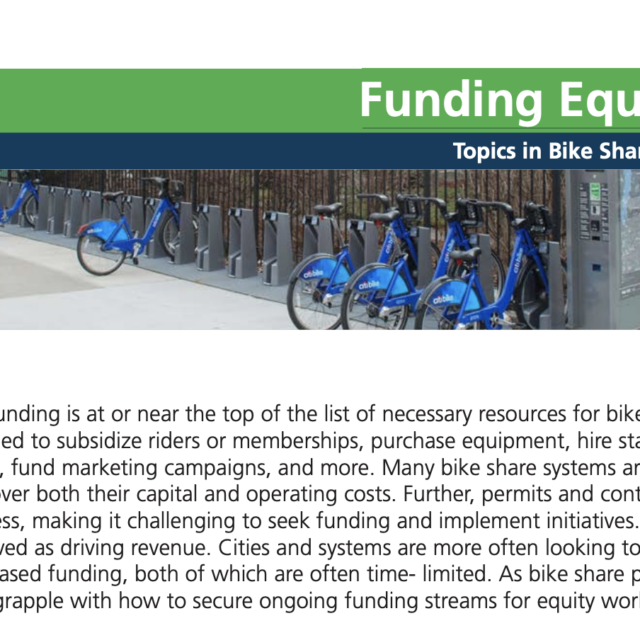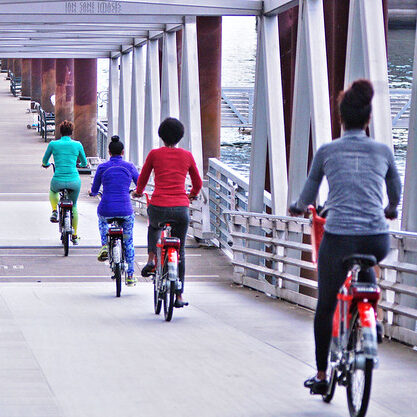Breaking Barriers to Bike Share Briefs: An Inside Look
by Farrah Daniel, Better Bike Share Partnership Writer
August 20, 2020

The growth of bike share within the last 10 years is accompanied by new demands and increased efforts to make sure bike share systems are accessible to everyone, especially those who have the fewest resources or live in communities that have been historically underserved. As the COVID-19 pandemic continues to teach us valuable lessons about the importance of transportation options for marginalized communities, now more than ever, the prioritization of equity within bike share and shared micromobility can no longer be a question.
To better understand how the bike share landscape was adapting to efforts to improve equity, in 2019, Portland State University researchers Nathan McNeil, John MacArthur, Joseph Broach and Austin Cummings created the National Scan of Bike Share Equity Programs, a 130-page report created to learn about programs and initiatives addressing equity in bike share. One year later, this report continues to help cities and operators learn from the experiences of others to achieve greater equity in their bike share systems.
To make the report more accessible, the researchers created 10 2-pagers that highlight the key takeaways from systems across the country who have been successful in making sure all voices are heard in their bike share programs. Recently, we broke down the TREC x PSU Breaking Barriers to Bike Share briefs and explained exactly what you’ll learn in them.
And today, we’re giving you a behind-the-scenes look, thanks to McNeil and MacArthur, who joined BBSP for a conversation about the development of these briefs.
The Origin: The National Scan of Bike Share Equity Programs
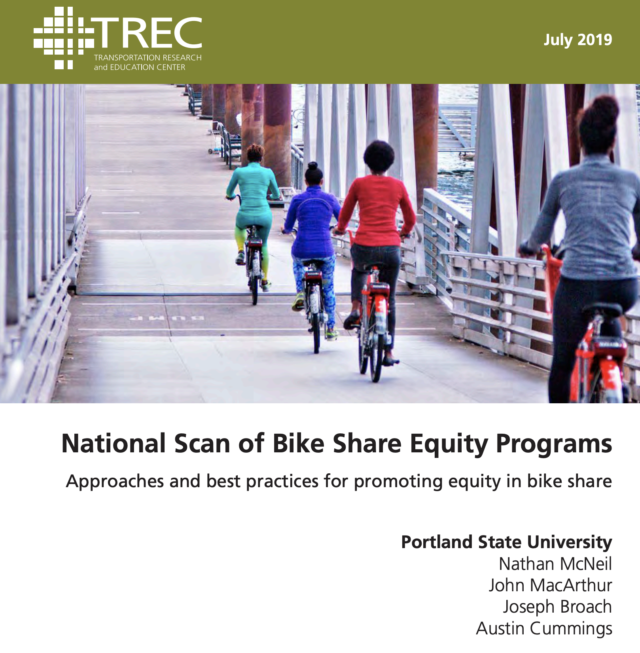
McNeil, MacArthur, Broach and Cummings had one big question: What makes bike share truly equitable? To find the answers, the researchers sought to identify ways for cities and bike share systems to have these conversations with meaningful data.
The National Scan of Bike Share Equity Programs report is a resource to help cities navigate the range of ways they can implement and make bike share systems more equitable by examining successful strategies employed by other cities and systems, and understand how those systems are measuring and articulating their successes and challenges.
The findings of this report were based on a questionnaire of bike share operators, cities and community partners, data collected during a scan of systems and follow-ups with select cities and systems:
- Researchers developed and tested a questionnaire designed to collect detailed information on the various programs and approaches that were being used in cities around the U.S. to improve equity in bike share.
- They sent the survey to 245 contacts working in 131 bike share systems.
- They received 85 valid responses, plus one response from bike share systems in 70 cities across 34 states.
- From those responses, they received information on 105 different equity programs. (Note: Many systems having more than one program.)
- The survey responses guided their selection of cities to do in-depth case studies.
“We ended up tiering the systems by how important we felt their response was based on trying to get a variety of city sizes and system types, so we tried to make sure we got a mix of large cities, medium-sized and small cities. We also made a special effort to try to engage people we knew received BBSP funding because that was an important perspective,” explains McNeil. He continues and says, “Getting the BBSP Research Grant recipients is a good cross-section to look at because I think we ended up getting all but one of those systems to respond; so in that case, we got 95% of the systems to respond. In the end, we felt like we got a pretty representative sample.”
In the surveys, the researchers focused on gaining three perspectives from each city: Operators, cities and community organizations working with systems on equity issues.
The questionnaire responses were filled with creative and innovative approaches to improving equity in bike share — to conclude the report, researchers shared System Spotlights, which are case studies that provide a bigger picture of these efforts. And in July of 2020, ten bike share briefs were published that extracts everything that makes these systems successful in improving bike share equity across the country.
Breaking Barriers to Bike Share Briefs: The Development
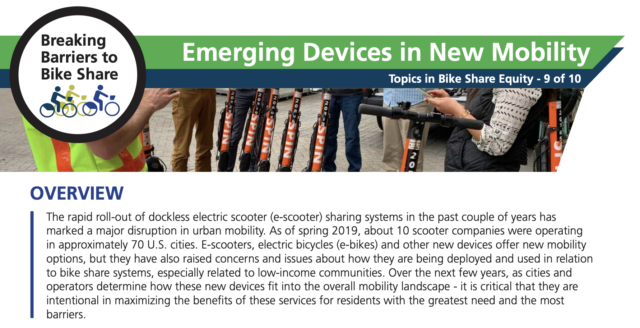
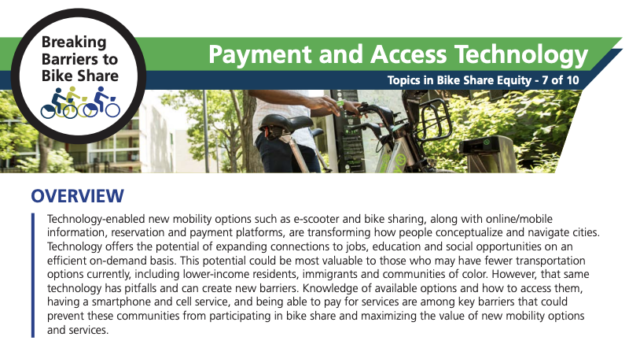
While the researchers received great feedback that people appreciated the overview of what other cities were doing, one big issue reigned supreme: The length of the report. Unfortunately, many people couldn’t get past how cumbersome the report is, so part of the researcher’s motivation for creating these briefs was simply to make it accessible and less intimidating.
Let’s take a closer look at the background of how these essential bike share briefs came to be.
How and why these briefs were created:
NM – The report we released last year ended up being about a 130-page report, which was, in some ways, longer than we intended, but we just felt like we had gotten a lot of great information from cities and wanted to share it. We wanted some way to acknowledge that most people weren’t gonna have time to read a huge report, [so we got] the information down into a pretty condensed format and made it topical so the most somebody would need to read is a page or two to get the gist of some of the key findings. Most of the information came from that scan of bike share systems, which was, in large part, a survey of what they were doing. The briefs are, ‘here are a few things that are happening in places that are trying to address this topic; here are some of the key considerations to keep in mind when implementing such a program.’
Then, throughout both the report and the briefs, we tried to maintain some sense of the notion of collecting good data about the programs, so that systems are better at documenting what’s happening in their programs and reporting on that so they can improve [while showing] to the public and to any potential investors that this is a program worth investing in and worthwhile of the time and money put into it. Or alternatively, ‘we need to change and we need to figure out a way to better reach people.’
How they chose the topics and recommendations to feature:
JM and NM – As part of the project […] we came up with the idea of these briefs to distill what we have in that report into two-pagers on topics, and we got those topics through a technical advisory committee that we used for the project. The technical advisory committee was representative of bike share systems from around the country and we tried to get a mix of people who worked for bike share systems, people who worked for cities, people who worked for community organizations involved in bike share. While they helped us select the topics, we brought a broad range of potential topics to them and used them to narrow it down to the most important ones, or the idea of what would be most useful to get more information to cities and bike share systems.
Most of the [topics and recommendations] featured in the briefs are pulled from the cities that we interviewed for the case studies, so that was a really good way for us just to get a better handle on what their experience was and the specifics of the impact of a particular approach or program. We selected case studies based on cities that were doing interesting things and taking innovative approaches. And because we had more detailed information from those cities, the briefs often featured those stories. But that said, there were cities that we couldn’t feature in the case studies, but there were still a lot of good ideas there that we were able to draw from for examples in the briefs.
On how much was known industry-wide about bike share equity at the start of their research efforts with BBSP:
JM and NM – I think we came Portland State — John, myself and Jennifer Dill, who helped on [Breaking Barriers to Bike Share in 2017] — through expertise in bicycling. We’ve done some work in bike share about the motivations for considering riding a bike and what the barriers are. I think before then, there hadn’t been a lot of bike share research in general before we started that project. But I think BBSP, to a large degree, created this, both the research side with the focus on bike share equity, but also, in many ways, the practice side. And looking at the data that we found in our scan, something like half of the equity programs around the country received some sort of funding from BBSP, so a lot of places started thinking about this because of BBSP and because of the idea that BBSP was focusing on this.
— — — — — — —
Thank you to John MacArthur and Nathan McNeil for talking with BBSP about their research!
The Better Bike Share Partnership is a JPB Foundation-funded collaboration between the City of Philadelphia, the Bicycle Coalition of Greater Philadelphia, the National Association of City Transportation Officials (NACTO) and the PeopleForBikes Foundation to build equitable and replicable bike share systems. Follow us on Facebook, Twitter and Instagram or sign up for our weekly newsletter. Story tip? Write farrah@peopleforbikes.org

